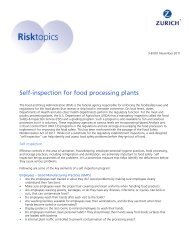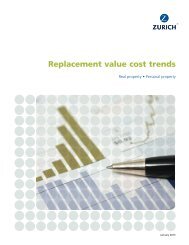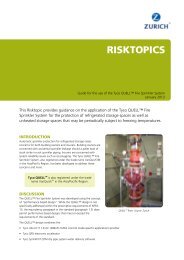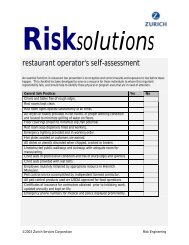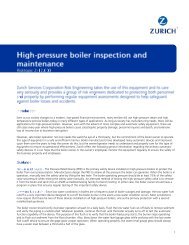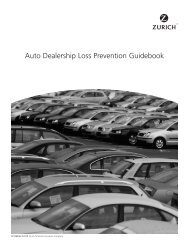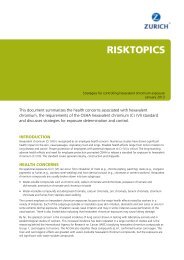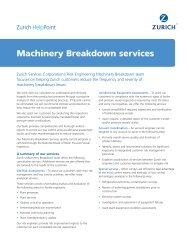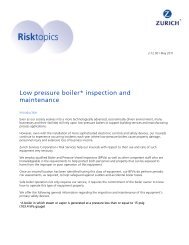Water Mist Fire Suppression Systems for ... - Risk Engineering
Water Mist Fire Suppression Systems for ... - Risk Engineering
Water Mist Fire Suppression Systems for ... - Risk Engineering
- No tags were found...
You also want an ePaper? Increase the reach of your titles
YUMPU automatically turns print PDFs into web optimized ePapers that Google loves.
• Limited fire test data and relevance of test compared to premises to be protected.• Ability to protect all areas of premises, e.g. stock rooms, gym stores, external canopies, kitchens andplant rooms, etc. not proven.• Ability to provide protection <strong>for</strong> different methods of construction, or products used in construction, notproven.• Ability to deal with design features of premises, which may affect per<strong>for</strong>mance of systems, e.g. Atriums,areas with ceilings over 5m high, open cell ceilings and plenums etc. not proven.• Ability to provide the protection against incidents involving deliberate ignition, where doors andwindows to protected areas, may well be open, following <strong>for</strong>cible entry.Design StandardsSprinkler installations are designed and installed by supervised companies to BS EN 12845. In addition to this,other fire protection standards are used such as Factory Mutual (FM) and National <strong>Fire</strong> Protection Association(NFPA). There is currently no equivalent British or European Standard to cover the design and installation of watermist systems, however, there are the standards described below.BS EN 12845: 2009The design of sprinkler installations <strong>for</strong> buildings, such as modern schools, offices and hospitals, is particularlychallenging due to the diversity of areas to be protected, the high number of other services to coordinate withand the nature, and <strong>for</strong>m, of the structures themselves. This inevitably leads to extensive <strong>Risk</strong> ImprovementAction points being created within our reports to cover the spacing and location of sprinkler heads, accuracy ofhydraulic calculations and areas of protection. All these items are, however, prescriptively set out within BS EN12845, providing us with a base level of acceptability.For reference purposes the following table sets out Ordinary Hazard Classification design criteria <strong>for</strong> sprinklersystems as stated in BS EN 12845:2009Occupancy Design Area of ExamplesClassification Density OperationOH1 5 mm/min 72m2 Class Rooms, Hospital WardsOH2 5 mm/min 144m2 Offices, Laboratories, Metal Workshops,Car Parks.OH3 5 mm/min 216m2 Plant Rooms, Storage Rooms, Retail Areas.OH4 5 mm/min 360m2 Theatres, Exhibition SpacesNFPA 750Tender specifications received <strong>for</strong> water mist systems often state 'in accordance with NFPA 750'. This is not a fully<strong>for</strong>med design document (such as BS EN12845 <strong>for</strong> sprinklers) and is not considered an extensive standard, but isviewed as a guidance document. It defines water mist, based on droplet size, as low pressure and high pressureand it refers to local application and area protection systems.It states that all systems and applications are required to have proven capability by means of risk specific, realisticfire per<strong>for</strong>mance tests, which must be carried out to suit the application and risk features. These tests must beverified by recognised approved test laboratories and all equipment must also be listed, as approved <strong>for</strong> thatapplication, and listed with UL FM, Vds, LPCB or similar approvals listing organisation.NFPA 750 states that systems with proven extinguishing capability, usually local applications such as industrialfryers, are required to have twice the proven water duration. Control systems, usually area protection systems,must have at least 30 minutes of water supply.



